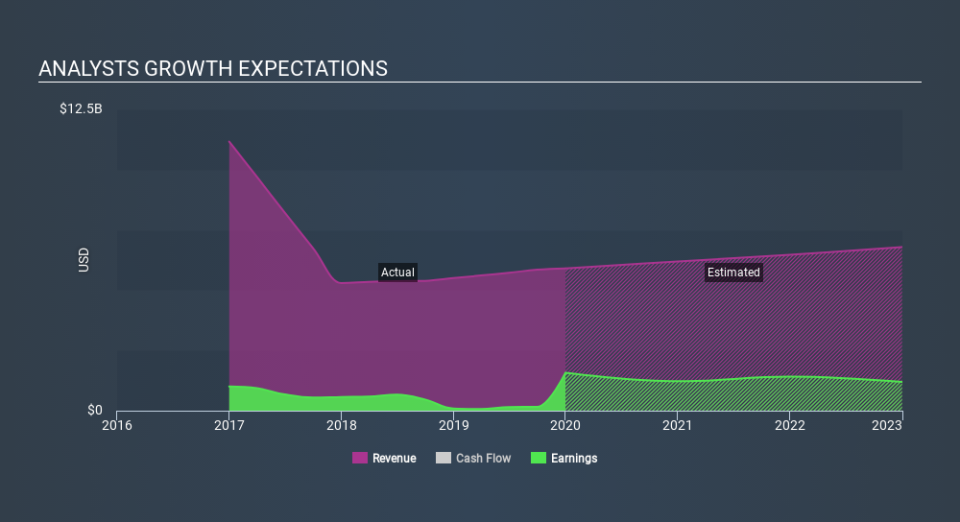Thomson Reuters Corporation Beat Analyst Estimates: See What The Consensus Is Forecasting For Next Year

Last week, you might have seen that Thomson Reuters Corporation (TSE:TRI) released its full-year result to the market. The early response was not positive, with shares down 4.7% to CA$103 in the past week. It looks like a credible result overall - although revenues of US$5.9b were what analysts expected, Thomson Reuters surprised by delivering a (statutory) profit of US$3.11 per share, an impressive 290% above what analysts had forecast. Analysts typically update their forecasts at each earnings report, and we can judge from their estimates whether their view of the company has changed or if there are any new concerns to be aware of. So we collected the latest post-earnings statutory consensus estimates to see what could be in store for next year.
See our latest analysis for Thomson Reuters
Taking into account the latest results, the current consensus from Thomson Reuters's 13 analysts is for revenues of US$6.19b in 2020, which would reflect a reasonable 4.9% increase on its sales over the past 12 months. Statutory earnings per share are forecast to nosedive 59% to US$1.30 in the same period. Before this earnings report, analysts had been forecasting revenues of US$6.21b and earnings per share (EPS) of US$1.88 in 2020. Analysts seem to have become more bearish following the latest results. While there were no changes to revenue forecasts, there was a pretty serious reduction to EPS estimates.
Although analysts have revised their earnings forecasts for next year, they've also lifted the consensus price target 9.0% to US$77.02, suggesting the revised estimates are not indicative of a weaker long-term future for the business. There's another way to think about price targets though, and that's to look at the range of price targets put forward by analysts, because a wide range of estimates could suggest a diverse view on possible outcomes for the business. The most optimistic Thomson Reuters analyst has a price target of US$91.81 per share, while the most pessimistic values it at US$50.21. This shows there is still quite a bit of diversity in estimates, but analysts don't appear to be totally split on the stock as though it might be a success or failure situation.
One way to get more context on these forecasts is to look at how they compare to both past performance, and how other companies in the same industry are performing. For example, we noticed that Thomson Reuters's rate of growth is expected to accelerate meaningfully, with revenues forecast to grow at 4.9%, well above its historical decline of 20% a year over the past five years. Compare this against analyst estimates for the wider market, which suggest that (in aggregate) market revenues are expected to grow 4.8% next year. So while Thomson Reuters's revenues are expected to improve, it seems that analysts are expecting it to grow at about the same rate as the overall market.
The Bottom Line
The biggest concern with the new estimates is that analysts have reduced their earnings per share estimates, suggesting business headwinds could lay ahead for Thomson Reuters. Happily, there were no real changes to sales forecasts, with the business still expected to grow in line with the overall market. Analysts also upgraded their price target, suggesting that analysts believe the intrinsic value of the business is likely to improve over time.
With that said, the long-term trajectory of the company's earnings is a lot more important than next year. We have forecasts for Thomson Reuters going out to 2022, and you can see them free on our platform here.
You can also see whether Thomson Reuters is carrying too much debt, and whether its balance sheet is healthy, for free on our platform here.
If you spot an error that warrants correction, please contact the editor at editorial-team@simplywallst.com. This article by Simply Wall St is general in nature. It does not constitute a recommendation to buy or sell any stock, and does not take account of your objectives, or your financial situation. Simply Wall St has no position in the stocks mentioned.
We aim to bring you long-term focused research analysis driven by fundamental data. Note that our analysis may not factor in the latest price-sensitive company announcements or qualitative material. Thank you for reading.

 Yahoo Finance
Yahoo Finance 
